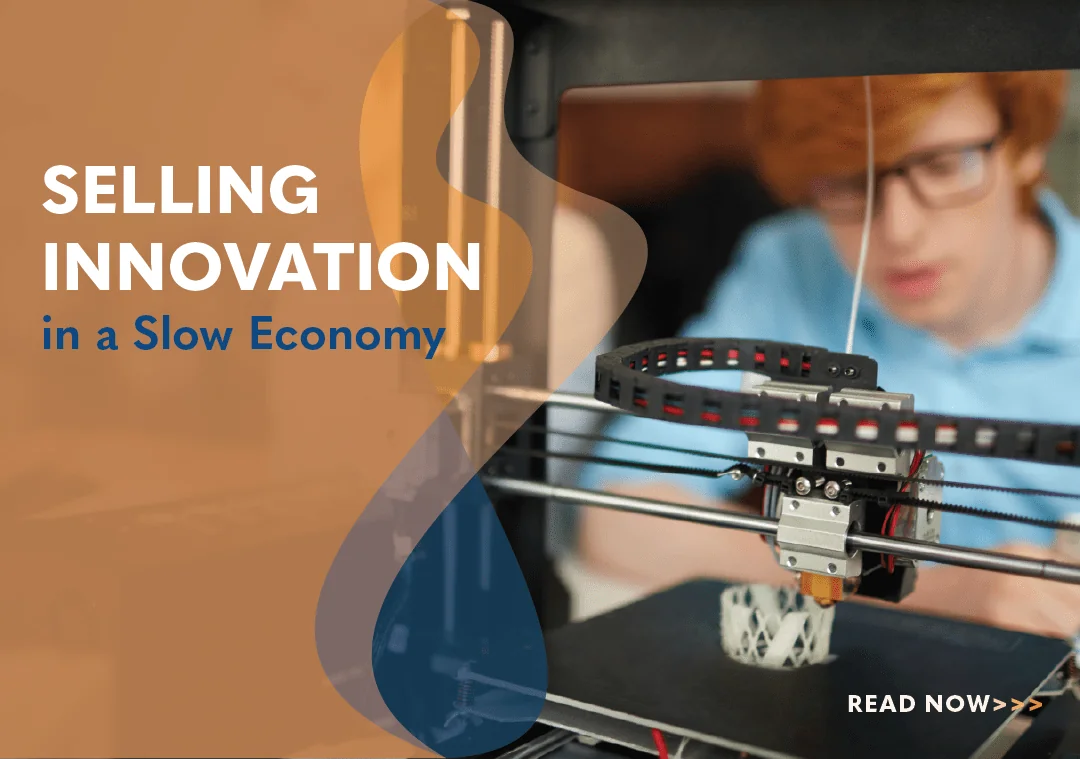Selling Innovation in a Slow Economy

“We have a game-changing, disruptive technology, but the economic environment is slowing down our sales,” said a CEO recently. Selling disruptive technology has an image problem. Selling disruption would get more respect if it was not called disruptive. There needs to be more than technological innovation to ensure sales success. This article explores the challenges of selling disruptive solutions and how sales leaders can improve their results, even in an economic slowdown.
There’s a hysteria around disruptive innovation. The oversold, entrepreneurial myth that the young technology genius will develop a solution that makes previous solutions irrelevant. Innovations alone do not become disruptive. Companies with good sales strategies do. Rejecting the myth of disruption and returning to a more rational sales reality is a foolproof way to improve sales.
The Innovators Dilemma
Clayton Christiansen, the author of Innovators Dilemma and a Harvard Business School professor, says disruptive innovations can change the competitive dynamics of an industry. The challenge for sellers is that every company with a new widget will tell their buyers that it’ll be disruptive. But disruptive technologies are only realized after the fact. Predicting if a new technology will be disruptive is nearly impossible, even for Clayton Christensen, who said, “Apple would fail with the iPhone.”
Alternatively, innovative products fail to become disruptive because management failed to find the blind spots. More than innovation is needed to ensure sales success. The history books are filled with companies that should have capitalized on their innovative technology. Here are a few:
- Kodak revolutionized photography with the invention of the digital camera but failed to shift from film to digital. They also developed a disruptive technology in the form of the Photo CD, which offered high-quality digital images but failed to properly commercialize and protect its technology, leading to its decline.
- BlackBerry was a pioneer in the smartphone market but was slow to adopt the touchscreen technology that became dominant and was eventually overtaken by competitors such as Apple and Samsung.
- Xerox had a strong research and development team, but it could not effectively bring its innovations to market. Its breakthroughs, such as the graphical user interface, needed to be appropriately commercialized.
These companies were innovative but lacked a clear sales strategy to commercialize their innovations. The ability to bring innovative products to market is a skill. Developing that skill is an unpopular opinion. The popular view is “Build it, and they will come.” Unfortunately, the hard reality is that bankruptcy courts are filled with innovative companies’ reorganization under chapter 11.
Return to Reality
In business, disruptive sales are not an accident. It requires intention, strategy, and skills. Yes, disruptive innovations occur, but not at the frequency that startup entrepreneurs and founders claim. The company that launches a new product and calls it disruptive before it scales sets the sales team up for failure. This mindset creates blind spots, and management never sees the failure coming.
CEOs with an engineering or coding background often find themselves in self-denial about their ideas. Being creative and innovative is futile if you can’t get past first base, going out and selling what you create. Commercializing the product at scale is second base and requires a repeatable sales process. When sales teams fail to scale innovative products, there can be several reasons, including:
- Lack of clear goals and objectives: Without a well-defined process and strategy, sales teams can become disorganized and lack direction.
- Inadequate training and development: Sales teams need continuous training and support to stay up to date on industry trends, product knowledge, and sales techniques.
- Poor communication: Effective communication is essential for sales teams to work together and achieve common goals.
- Lack of teamwork: Sales teams that lack a sense of collaboration and teamwork are often less productive and efficient.
- Resistance to change: Sales teams that resist change can be left behind as their competition adopts new strategies and technologies.
- Inadequate technology and resources: Sales teams need access to the right tools and resources to be effective, such as customer relationship management (CRM) systems, sales enablement software, and market intelligence data.
- Inadequate motivation and incentives: Sales teams need to be motivated and incentivized to perform at their best. Otherwise, they may become disengaged and demotivated.
- Poor management: Sales teams require strong leadership and effective management. Poor sales management can lead to low morale, poor performance, and high turnover.
Disruption results from a well-defined process, not a product or service. When companies launch a new technology, the best sales process is often figuring out how to integrate the new solution with the customer’s current reality. Beginning disruptive is not only about gaining market share. It’s more about creating and sustaining superior value for customers. When selling innovative solutions, sales teams need to fall in love with the problems they solve, not the product.
Silence the Inner Critic
Most CEOs have a vague notion that their business should be doing better. Until that notion becomes a strong conviction, there is little urgency to change. Every decision-maker has an inner critic that says, “This new solution is overrated and not worth the effort.” This internal critic sabotages new initiatives. Innovative solutions produce resistance and reluctance.
For example, we’ve been in sales training for nearly two decades. What we’ve learned doesn’t work is to approach a client and say, “What you’re doing is outdated, ineffective, and substandard.” Yet, this is the non-spoken premise of disruption. This approach creates resistance whether you are providing sales training or new technology. Resistance is a natural aversion to being told to change by others.
At Janek, we co-create new sales strategies with every customer. Most sales leaders understand there is room for improvement within their sales department. To silence the inner critic, we provide evidence of how we helped companies with similar challenges improve results. Evidence creates common ground to agree upon.
Additionally, co-creating solutions silences the inner critic and opens the door to creating value. Sales teams with the skills to co-creating evidence-based solutions for customers have a sales model for the future. When participants are involved in co-creating solutions, it avoids the bet-the-farm; this is the only way it works with initiatives that often end in rejection or failure.
However, when companies bring innovative solutions to the market, they confuse the information for evidence. Decision-makers can easily ignore information because their inner voice tells them everything is fine. Evidence-based solutions are harder to ignore. The better the sales rep ties the new evidence to the decision-maker’s current situation, the harder the innovation is to ignore.
Why Selling Disruption Does Not Work
Many companies have disrupted industries. Amazon disrupted retail. Uber disrupted transportation. Netflix disrupted movie rentals. While they were on their journey of being “disruptors,” they were fighting for their lives to generate enough revenue to stay in business. Disruption is not a feature to be sold. When sales reps position their solution as a disruptor before they disrupt, it oversimplifies the complex process of innovation. This oversimplification in the sales process leads to slow sales and, if not corrected, eventually, failure.
In every industry, companies are making bold claims about their solution. These claims place too much emphasis on technology as the sole driver of innovation, ignoring the critical role of the problem being solved, business workflows, and organizational culture. These bold claims have led to a loss of trust and credibility among all decision-makers. If disruption had been oversold and now falls on deaf ears with decision-makers, what is the best strategy for early innovators? Let’s explore.
Sales Skills Drive Innovation
Most new innovations have loud critics, and even the most innovative products rarely sell themselves. Changing a decision-makers business beliefs is a complex process and needs to be evidence-based. Using data and facts while presenting objective data and research can help to build a persuasive argument with modern buyers.
Acknowledging the decision-maker’s current perspective and trying to understand their reasoning also helps. Co-creating is an effective way to integrate new innovations into the customer’s existing workflow. Sharing real-world experiences and stories helps illustrate the actual impact of a particular business function or challenge.
One undebatable aspect of human nature is that we are all biased. Counteracting this natural bias is why an evidence-based approach to selling is paramount. Psycholinguistics studies the psychological and neurobiological processes involved in language processing. Psycholinguistics can impact the believability of messages and information. For sales reps and companies selling innovative solutions, the believability of messages can be impacted in several ways:
- Language fluency: Fluent language use can increase the perceived credibility of a sales message, as buyers are more likely to believe sales reps who can articulate their ideas clearly and concisely.
- Persuasive language: Certain linguistic techniques, such as using inclusive language or avoiding negative words, can increase the persuasive power of a message and make it more believable.
- Emotional language: The use of emotional language, such as using strong adjectives or making appeals to empathy, can increase the perceived believability of a message by tapping into people’s emotions and affecting their attitudes and beliefs.
- Cognitive ease: People are more likely to believe information that is easy to process and understand, as their brains process familiar information more quickly and easily.
- Context and framing: How information is framed and presented can affect its perceived believability. For example, information presented in a positive context or framed as a solution to a problem is more likely to be seen as credible.
These are just a few examples of how psycholinguistics can impact the believability of a sales message. Understanding these processes can be valuable for sales reps looking to create messages that are believed and acted upon.
Great sellers can concisely communicate the impact of their solution to strangers. On the other hand, talkaholics spend less time on the impact of solving the problem and too much time on technology. Ineffective selling sounds scripted, robotic, stiff, and canned. Effective selling helps decision-makers see how to accomplish their long-term vision.
High-performing sellers share these common traits:
- They sound conversational.
- They encourage agreement.
- They promote meaningful conversations.
The value of these sales skills is at an all-time high. Today, if these skills are lacking, sales reps are not making the impact they are capable of, even if the new technology is transformative. If your sales team is falling short with their sales results, it’s time to overreact like you never overreacted before.
Conclusion
There is often a rush to judgment when companies launch new technology solutions. They overestimate the “no-brainer” component and underestimate the sales skills element. When companies fail to scale a new product or service in their industry, it is likely a combination of ineffective sales strategy and sales management rather than a technology shortfall.
Companies that develop innovative technologies need a comprehensive and well-executed sales strategy. Technology alone is not enough to bring new solutions to market, reach target customers, and establish a sustainable competitive advantage. Disruption is not an event but a process. Companies that overplay the disruption card undermine the value they bring to potential customers while hindering sales.
Comments are closed.

- Account Planning (11)
- Awards (49)
- Client Testimonial (37)
- Personal Branding (19)
- Podcast (11)
- Research (70)
- Sales Career Development (87)
- Sales Coaching (156)
- Sales Consulting (137)
- Sales Culture (170)
- Sales Enablement (354)
- Sales Leadership (109)
- Sales Management (248)
- Sales Negotiation (16)
- Sales Prospecting (125)
- Sales Role-Playing (18)
- Sales Training (235)
- Selling Strategies (263)
- Soft Skills (70)
- Talent Management (94)
- Trusted Advisor (27)
- Virtual Selling (49)
- Webinar (9)



























Very good article. My comment will be that at the end of the day no matter what you are selling if is a common product or a disrupted innovation article or service, the success will be very much supported by a sound and robust sales strategy and a very well training and focus sales team. Under the sales strategy a deep knowledge of the decision-maker current necessities and momentum to aligned time frame and scale of results will be critical. If the situation allow to share preliminary experiences to avoid decision-maker ignore proposal will be even better.